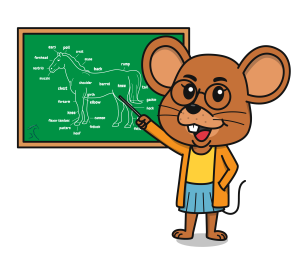Tony the Cat, checking back in again. The girls have been talking a bit about horse nutrition over the past couple of weeks, and I thought you guys might be interested in some of the facts, and what they mean when it comes to feeding your riding buddies. As you probably already know, horses are herbivores; which means their diet consists of plants. Horses are adapted to eating up to 20 hours a day! I need more cat naps than that. Because they eat so regularly, they are also adapted to eating small amounts of food at one time. The average horse’s stomach holds about 1-3 gallons of food. That’s not very much when you think of how big they are! To make matters even more interesting, horses can’t regurgitate. If they get too full, or they eat something that is toxic to them, it cannot come back up. This can lead to a multitude of problems, including colic and ulcers. Following the stomach is the small intestine. The small intestine is 50-70 feet long, and is where most of the digestion of easily digested nutrients occurs. The Cecum follows the small intestine, and can hold 7-8 gallons. This is where fiber fermentation begins. Last but not least is the large colon, which has four parts and which is where most impactions occur. This is where the final stages of fiber digestion occur before the leftovers are sent to the rectum to be disposed of. Horses are technically known as hind gut fermenters; which means they have a simple stomach and most digestion occurs in their intestine, especially the large intestine. They also have no gall bladder, so they generally can’t have a diet high in fats. Fats are digested through the lymph system in horses, and distributed through that system as well. Now that we’ve covered the basics of the anatomy of a horse’s digestive system, let me go a little more in depth on their requirements.
Mature horses generally require 3.4 megacalories (that’s 34,000 calories) of food per 100kg (1kg = 2.2lb) of body weight. That requirement fluctuates depending on the amount of activity the horse is involved in each day. An 1100 lb horse will normally require at least 16.4Mcal per day. The horse’s daily requirements can be as much as doubled depending on how much riding is done. Pleasure horses generally will only have a slightly raised requirement of calories per day. A horse in heavy competition training would need up to double. Around 80% of the calories consumed should be from grazing and roughage. Horses’ diets rely heavily on carbohydrates and fibers found in vegetation. If your horse has limited turn out, then you should ensure he or she is getting plenty of quality hay. Concentrates should be the minority in a horse’s diet. Some fiber alternatives can also be fed when grazing roughage is low. These include beet pulp, and various cubes. Horses get some proteins and fats from their roughage as well, which is again why a plentitude of forages should be supplied. Forage options besides good pasture include coastal hay, Timothy blends, oat blends, Alfalfa, peanut hay, and various other grasses. Alfalfa is available on its own, but is also one of the more common blends with Timothy grasses and oats. Hays can be obtained through feed stores and directly from growers, and you should search for good quality sources. Hay should be low in dust, relatively dry, with medium long cuts. Alfalfa and blends that include it will be greener and are richer. They should be introduced gradually to ensure the horse’s system can adapt properly. Coastal hays and peanut hay are aged a bit more, and can include some green but will generally take a more yellow huge with age. They tend to be drier and not quite as nutrient dense.
All of this talk of food can sure get a cat’s appetite up, I hear a food bowl calling my name. In next week’s blog, I’ll talk more about fats, proteins, carbohydrates, and their effects on the horse’s body. At the end of this blog series, I’ll also provide a few extra reading sources in case you’d like to study nutrition further. In the meantime, may your litter box always be clean and your food bowl full.
